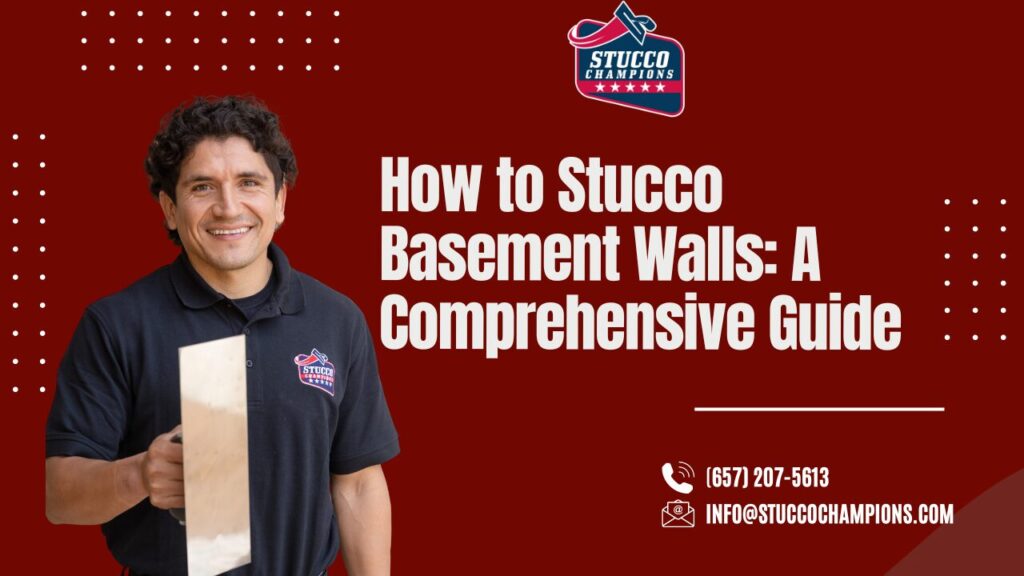In this comprehensive guide, we delve into the process of stuccoing basement walls, providing detailed instructions, expert tips, and solutions to common issues. Whether you’re a beginner or an experienced DIY enthusiast, this guide aims to equip you with the necessary knowledge to successfully stucco your basement walls.
Expertise and Qualifications:
I bring to this guide years of hands-on experience in stucco application, having worked on numerous projects that span different techniques and challenges. This experience has granted me a deep understanding of the nuances of stucco work, from preparation to finishing touches.
Tools Needed for This Project:
The Basics:
- Water hose and nozzle
- Trowel and hawk
- Green floats
- Hard rubber float (for base coat)
- Covering material
- Mixing drill, paddle, buckets or a mixer
- Power cord
For An Acrylic Finish:
- Paint roller frame and pad (3/4″ nap)
- Paint tray or screen
- Specialty trowels for unique finishes
For Traditional Finish:
- Large bin for mixing (if using a mixing drill)
For The Base Coat:
- Darby or featheredge (optional for wall straightening)
Interior vs Exterior Basement Walls:
There is no significant difference in the stucco application process between interior and exterior basement walls. However, for exterior walls, a skim coat is recommended to cover grout lines and rough spots.
Preparation Before Plastering:
Proper preparation is crucial for a successful stucco application. Ensure the wall is flat, free of high spots or ridges. Clean the walls thoroughly, preferably by pressure washing, to remove dust and debris. Patch visible holes, cracks, or defects before applying any coats.
The Easiest and Cost-Effective Way to Stucco Basement Walls:
Advantages:
- Fastest and most inexpensive method
- Suitable for walls in good condition
Disadvantages:
- Imperfections may show through
- Less durable than methods involving a base coat
Step-by-Step Process:
Step 1: Watering or Priming the Walls: For traditional finishes, ensure walls are moistened. For acrylic finishes, apply the appropriate primer.
Step 2: Mixing the Stucco: Choose a method (bucket, wheelbarrow, or mixer) that suits the project’s size. Adding color to the stucco is recommended for durability and aesthetics.
Step 3: Applying the Finish Coat: Use a hawk and trowel for application, maintaining a thickness of 1/16″ to 1/8″. Follow a spreading sequence to avoid joint lines and ensure uniform coverage.
Texturing the Wall:
After spreading the stucco, texture it according to your chosen style. For example, a sand finish can be achieved using a green float.
A More Thorough Approach: Using a Base Coat
This method involves applying a base coat before the color coat, leading to superior results.
Advantages:
- Covers cracks and imperfections effectively
- Allows for a wider range of textures and finishes
Disadvantages:
- More time-consuming and costly
- Requires more skill to apply the base coat correctly
Step 1: Watering the Walls: Soak the walls before beginning the project to aid in moisture retention during application.
Step 2: Mixing and Applying the Base Coat: Choose a suitable base coat material based on your wall’s condition. Hydraulic cement is recommended for moisture-prone areas.
Step 3: Let the Base Coat Cure: Allow the base coat to cure for 2-3 weeks, ensuring optimal strength and minimizing cracking.
Step 4: Apply the Finish Coat: Apply the finishing coat evenly, adhering to the same principles and techniques outlined in the skim coat method.
Addressing Common Issues with Basement Walls:
Moisture: Differentiate between condensation and genuine leaks. Address external water intrusion issues before interior stucco application.
Mold: Tackle underlying water issues before removing mold. Ensure the area is dry and free from moisture sources.
Deterioration/Damage: Assess and repair any structural damage using appropriate materials before stucco application.
Leaks: Investigate and correct external causes of leaks, such as poor drainage or faulty downspouts.
Bowed Walls: Address structural issues causing wall bowing before proceeding with stucco work.
In conclusion, stuccoing basement walls is a viable and aesthetic solution for enhancing the durability and appearance of your basement. With the right tools, preparation, and techniques, this guide aims to provide you with a comprehensive understanding of the stucco.
Last week’s post, White Stucco Houses – A Comprehensive Guide to Elegance and Style, explored the timeless appeal of white stucco exteriors. We discussed the design versatility, maintenance tips, and aesthetic benefits of choosing white stucco for a sophisticated and durable home exterior.
—
Ready to Work With a Trusted Stucco Repair Contractor? Contact Stucco Champions today for a free consultation! Visit us at Stucco Champions for valuable resources and to learn more about our expert stucco repair services.

